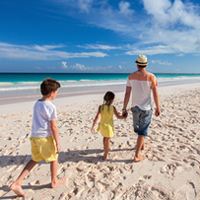Public Transportation in Siargao Island
Summary: Learning how to get around using public transportation in Siargao Island is an important step in adjusting to life in Siargao Island. In this article, we cover the local public transportation options.
Siargao Island, known for its stunning landscapes and world-class surfing spots, has become a haven for digital nomads seeking a tropical backdrop for their remote work lifestyle. While the island's beauty is undeniable, getting around can be a bit of a challenge for newcomers. Understanding the public transportation options available is essential for those looking to explore Siargao's nooks and crannies without the hassle of renting a car or relying on expensive private transfers.
Motorbikes and Scooters
One of the most popular and convenient ways to get around Siargao is by renting a motorbike or scooter. This option offers the freedom to explore at your own pace and is ideal for those comfortable with driving on less developed roads. Rentals are widely available across the island, and you can expect to pay around PHP 350 to PHP 500 per day. Always wear a helmet and be cautious of the sometimes unpredictable road conditions.
Tricycles
Tricycles, the Philippine version of the auto-rickshaw, are a common sight on Siargao and serve as a primary mode of public transportation. They are perfect for short distances or if you're traveling with a bit of gear. Fares are relatively cheap, but it's advisable to agree on the price before starting your journey to avoid any confusion. For longer distances, you can also hire a tricycle for a private tour at a negotiated rate.
Jeepneys and Multicabs
Jeepneys and multicabs are the Philippines' iconic shared transportation options, and they operate on Siargao as well. They follow specific routes and are a very affordable way to travel between different parts of the island. However, schedules can be irregular, and routes may not cover all tourist destinations, so it's essential to plan accordingly. For the latest information on routes and schedules, it's best to ask locals or at your accommodation.
Boats
For digital nomads looking to venture to the surrounding islands or remote beaches, boats are the way to go. Public boats, known as bangkas, can take you on island-hopping tours or to specific destinations like Daku Island, Guyam Island, or Naked Island. Prices and schedules vary, so check with local operators or your accommodation for the most up-to-date information.
Helpful Apps
While Siargao doesn't have the same level of app-based transportation services as larger cities, digital nomads can still use apps like Maps.me or Google Maps for offline navigation. These apps can be handy for planning your routes, especially when exploring by motorbike or scooter. Additionally, local tourism websites and social media groups can be valuable resources for real-time updates and tips from fellow travelers.
Safety
Safety should always be a top priority when using public transportation in Siargao. Always check the condition of any rental vehicle, particularly brakes and lights, before heading out. Be aware of local traffic laws and customs, and avoid traveling late at night on poorly lit roads. When on boats, ensure that life jackets are provided and that weather conditions are favorable for your journey. Lastly, always keep your belongings secure and be mindful of your surroundings, especially in crowded areas.
As Siargao continues to grow in popularity among digital nomads, the island's transportation options are likely to expand and improve. For now, the available modes of transport offer a charming and authentic way to experience the island's culture and natural beauty. With a little planning and some local advice, you'll find navigating Siargao to be part of the adventure that makes this destination so unique.
About the Author
 Joshua Wood, LPC is one of the Founders of Digital Nomad Exchange and serves as Co-President of Expat Exchange. Prior to Expat Exchange and Digital Nomad Exchange, Joshua worked for NBC Cable (MSNBC and CNBC
Primetime). Joshua has a BA from Syracuse and a Master's in Clinical and Counseling Psychology from Fairleigh Dickinson University. Mr. Wood is also a licensed counselor and psychotherapist.
Joshua Wood, LPC is one of the Founders of Digital Nomad Exchange and serves as Co-President of Expat Exchange. Prior to Expat Exchange and Digital Nomad Exchange, Joshua worked for NBC Cable (MSNBC and CNBC
Primetime). Joshua has a BA from Syracuse and a Master's in Clinical and Counseling Psychology from Fairleigh Dickinson University. Mr. Wood is also a licensed counselor and psychotherapist.
Some of Joshua's articles include Pros and Cons of Living in Portugal, 10 Best Places to Live in Ireland and Pros and Cons of Living in Uruguay. Connect with Joshua on LinkedIn.

Get a quote for international health insurance from our partner, William Russell.
Get Quote
 William Russell
William RussellGet a quote for international health insurance from our partner, William Russell.
Get Quote
![]() Philippines Forum
Philippines Forum
Talk with other digital nomads and expats in Philippines on our Philippines forum - meet people, get advice and help others.
![]() Contribute
Contribute
Help others in Philippines by answering questions about the challenges and adventures of living in Philippines.
Digital Nomads in Philippines offer advice about healthcare, hospital visits, emergency rooms visits, finding a doctor and buying health insurance in Philippines.



